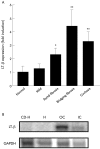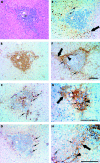Upregulation of lymphotoxin beta expression in liver progenitor (oval) cells in chronic hepatitis C
- PMID: 12912866
- PMCID: PMC1773812
- DOI: 10.1136/gut.52.9.1327
Upregulation of lymphotoxin beta expression in liver progenitor (oval) cells in chronic hepatitis C
Abstract
Background: Bipotent liver progenitor (oval) cells with the ability to differentiate into hepatocytes and biliary epithelium have recently been identified in human subjects with hepatitis C. Animal studies suggest that members of the tumour necrosis factor family, including lymphotoxin beta (LT-beta), regulate oval cell proliferation in liver disease, but its role in human liver disease is unclear.
Aims: This study seeks to establish a role for LT-beta in hepatitis C related liver injury and to provide evidence that its increased expression is related to the presence of oval cells.
Methods: Liver biopsy specimens were obtained from patients with chronic hepatitis C virus (HCV) infection (n=20). Control liver samples (n=5) were obtained from liver resection or transplant surgery. LT-beta expression in liver biopsy specimens was studied using quantitative real time polymerase chain reaction and immunohistochemistry.
Results: LT-beta mRNA levels were similar in control and HCV liver in the absence of fibrosis. In subjects with portal fibrosis, LT-beta mRNA levels were elevated 2.2-fold over control liver levels (p=0.04). In subjects with bridging fibrosis, LT-beta mRNA levels increased 4.4-fold over control liver levels (p=0.02). LT-beta mRNA levels in subjects with established cirrhosis were increased 3.3-fold compared with controls and 2.6-fold compared with mild liver damage (p=0.02). Immunohistochemical analysis established that LT-beta was expressed by oval cells, inflammatory cells, and small portal hepatocytes.
Conclusions: In chronic HCV infection, LT-beta expression is observed in multiple hepatic cell types, including oval cells. LT-beta expression is significantly increased when fibrosis or cirrhosis is present, suggesting a role for LT-beta in the pathogenesis of chronic hepatitis C and a possible role in oval cell mediated liver regeneration.
Figures


Similar articles
-
TWEAK and LTβ Signaling during Chronic Liver Disease.Front Immunol. 2014 Feb 13;5:39. doi: 10.3389/fimmu.2014.00039. eCollection 2014. Front Immunol. 2014. PMID: 24592262 Free PMC article. Review.
-
Hepatic expression of the tumor necrosis factor family member lymphotoxin-beta is regulated by interleukin (IL)-6 and IL-1beta: transcriptional control mechanisms in oval cells and hepatoma cell lines.Liver Int. 2005 Jun;25(3):633-46. doi: 10.1111/j.1478-3231.2005.01080.x. Liver Int. 2005. PMID: 15910501
-
Interleukin-32: a new proinflammatory cytokine involved in hepatitis C virus-related liver inflammation and fibrosis.Hepatology. 2011 Jun;53(6):1819-29. doi: 10.1002/hep.24285. Epub 2011 May 14. Hepatology. 2011. PMID: 21381070
-
Toll-like receptor-4 expression by hepatic progenitor cells and biliary epithelial cells in HCV-related chronic liver disease.Mod Pathol. 2012 Apr;25(4):576-89. doi: 10.1038/modpathol.2011.197. Epub 2011 Dec 16. Mod Pathol. 2012. PMID: 22173288
-
[Novel factors playing a role in the pathomechanism of diffuse liver diseases: apoptosis and hepatic stem cells].Orv Hetil. 2004 Aug 29;145(35):1787-93. Orv Hetil. 2004. PMID: 15493221 Review. Hungarian.
Cited by
-
Lymphotoxin in physiology of lymphoid tissues - Implication for antiviral defense.Cytokine. 2018 Jan;101:39-47. doi: 10.1016/j.cyto.2016.08.018. Epub 2016 Sep 9. Cytokine. 2018. PMID: 27623349 Free PMC article. Review.
-
NOD1 Participates in the Innate Immune Response Triggered by Hepatitis C Virus Polymerase.J Virol. 2016 Jun 10;90(13):6022-6035. doi: 10.1128/JVI.03230-15. Print 2016 Jul 1. J Virol. 2016. PMID: 27099311 Free PMC article.
-
Hepatic progenitor cells in chronic hepatitis C: a phenomenon of older age and advanced liver disease.Virchows Arch. 2010 Oct;457(4):457-66. doi: 10.1007/s00428-010-0957-x. Epub 2010 Aug 19. Virchows Arch. 2010. PMID: 20721577
-
TWEAK and LTβ Signaling during Chronic Liver Disease.Front Immunol. 2014 Feb 13;5:39. doi: 10.3389/fimmu.2014.00039. eCollection 2014. Front Immunol. 2014. PMID: 24592262 Free PMC article. Review.
-
Reverse Signaling of Tumor Necrosis Factor Superfamily Proteins in Macrophages and Microglia: Superfamily Portrait in the Neuroimmune Interface.Front Immunol. 2019 Feb 19;10:262. doi: 10.3389/fimmu.2019.00262. eCollection 2019. Front Immunol. 2019. PMID: 30838001 Free PMC article. Review.
References
-
- Vessey CJ, Hall PM. Hepatic stem cells: a review. Pathology 2001;33:130–41. - PubMed
-
- Sell S. Heterogeneity and plasticity of hepatocyte lineage cells. Hepatology 2001;33:738–50. - PubMed
-
- Evarts RP, Hu Z, Fujio K, et al. Activation of the hepatic stem cell compartment in the rat: role of transforming growth factor, hepatocyte growth factor, and acidic fibroblast growth factor in early proliferation. Cell Growth Diff 1993;4:555–61. - PubMed
Publication types
MeSH terms
Substances
LinkOut - more resources
Full Text Sources
Other Literature Sources
Medical
